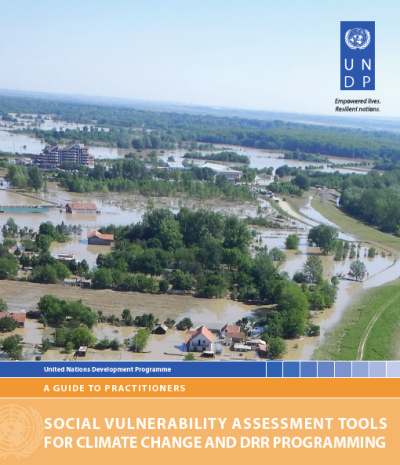
In the past twenty years, disasters cost more than US$2 trillion, killed over 1.3 million and affected more than 4.4 billion people, including a disproportionately high number of women, children and other vulnerable groups. Climate-related hazards, such as cyclones, droughts and floods, are becoming increasingly frequent and severe as a result of changing climate. In this new context of volatility, communities and nations are facing increasing, multiple and interconnected risks that can reverse years - and sometimes decades - of development progress.
Specific categories of the population may face a higher risk of disasters or climate change, related to the place they are living (flood prone parts of the community, for example), crops they are growing (i.e. low cost, low yield seeds, not resilient to climate change, for example); may have lower preparedness and coping capacity because they lack capitals to invest in adaptation and the decision making powers to affect public decisions on adaptation; may have lower resilience/adaptation capacity because they lack access to economic and social support networks.
Climate change adaptation and risk management interventions need to be planned, designed and targeted with the clear understanding of the social vulnerability profiles of various groups of beneficiaries. Numerous methodologies are used worldwide for assessing the impact of climate change and disasters on vulnerable population groups. Nevertheless, those social vulnerability methodologies are not systematically integrated into the overall process of climate and disaster risk management. Consequently, many studies that are meant to be “risk assessments” do not go beyond being “hazard assessments” as they lack standardized, comparable and quantifiable social dimensions of vulnerability.
A number of issues and challenges arise in defining and mapping the socially vulnerable population within climate change adaptation and disaster risk assessment frameworks. The variety of parameters used to determine social vulnerability includes, but is not limited to, income disparity, gender, age, disability, language, literacy or family status. However, personal characteristics can be linked to vulnerability, but not define it. Group approach is widespread because it is easy to administer and use for targeting the population, but it largely ignores the internal heterogeneity of groups.
Availability of data on social vulnerability (i.e. obtained from censuses, pre- and post-disaster studies, public surveys, etc.), and the level at which we conduct social vulnerability studies (individual, neighborhood, community, municipality, region, etc.) are critical issues in conducting social vulnerability assessments for climate change adaptation or disaster risk reduction programs. Finally, the tools for assessing social vulnerability have to be chosen for particular programmatic or investment decisions.
UNDP has been working on integrating issues of climate, disaster risk and energy at the country level, and focusing on building resilience and ensuring that development remains risk-informed and sustainable. Since 2008, UNDP has supported more than 140 countries in accessing over $2.3 billion in grant finance to develop and implement climate change initiatives. In the Europe and the Commonwealth of Independent States (ECIS) region, UNDP has been supporting a rich portfolio of project and policy initiatives addressing adaptation to climate change and disaster risk reduction. The UNDP projects in the region have addressed diverse climate-induced threats and impacts and targeted various adaptation and risk management objectives, ranging from improved resilience of agricultural livelihoods to reduced vulnerability of communities and economies to climate-induced natural disasters. These interventions are designed to target the most vulnerable people and communities and leave a legacy of inclusive gender-sensitive adaptation planning and risk reduction.
The aim of this Guide is to first and foremost serve as a user friendly knowledge product on Social Vulnerability Assessment (SVA) approaches and tools. This Guide provides information about on-going and future planning and programming in the areas of climate change adaptation (CCA), climate risk management (CRM) and disaster risk reduction (DRR). As such, it is primarily designed for CCA and DRR practitioners in national governments, local level authorities dealing with DRR/CCA, professional community and development organizations (including UNDP Country Offices and projects) involved in the planning, design and/or implementation of CCA and DRR projects. Thus, the Guide aims to improve the quality of CCA and DRR project development and implementation through enhanced initiation, targeting and increased effectiveness of future interventions. This guide should be taken only as an outline and a proposal that can assist project managers -DRR and CCA practitioners in developing social vulnerability studies dealing with climate change and disasters in specific countries.
